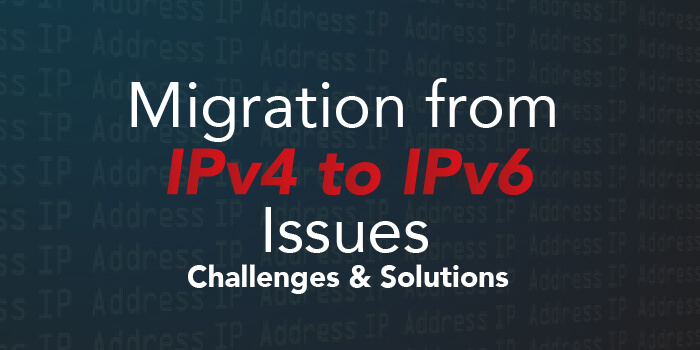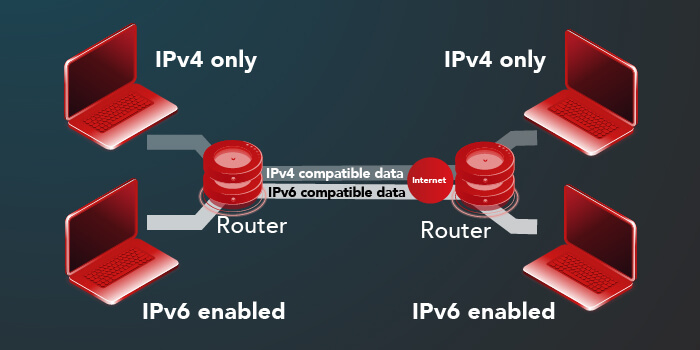![]()

June 30, 2023
Migration from IPv4 to IPv6 Issues – Challenges & Solutions
The migration from IPv4 to IPv6 is a topic of increasing importance as the exhaustion of IPv4 addresses looms. IPv4 has been the dominant protocol for Internet communication since its inception, but its limitations are becoming more apparent as the global demand for IP addresses continues to climb. Even though IPv6 offers several important advantages over IPv4, the transition from one protocol to another is not without its challenges. In this article, we will discuss the migration from IPv4 to IPv6 issues and how to get over them.
The Necessity to Migrate from IPv4 to IPv6
One of the primary reasons to migrate to IPv6 is the exhaustion of IPv4 addresses. IPv4 is limited to a maximum of 4.3 billion unique IP addresses, but the current number of internet-connected devices is far more than that. On the other hand, IPv6 has an address space of 128-bit that will provide practically an infinite number of unique addresses, thereby providing an adequate number of addresses even for future internet-connected devices. Thus, IPv6 will ensure the smooth and continued growth of the internet.
Additionally, IPv6 offers several advanced features that were not available in IPv4. Header extension, stateless address autoconfiguration, and improved security features are some of the new features that make IPv6 a more efficient and secure protocol. Also, IPv6 provides enhanced QoS (Quality of Service) and faster routing through the elimination of Network Address Translation (NAT). This will offer a better user experience and a more efficient network.
Furthermore, the migration to IPv6 is a worldwide initiative supported by various networking organisations and governments. Governments across the globe have already started promoting the usage of IPv6 and mandating a shift from IPv4. Many leading internet service providers have begun adopting and enabling IPv6, and numerous prominent websites and applications have already migrated to IPv6. Therefore, it is high time for enterprises to migrate to IPv6 to be compatible with the global standard.
Migration from IPv4 to IPv6 Issues
The Infrastructure
One of the primary issues with migrating to IPv6 is the sheer scale of the task. Given that IPv4 has been in use for over 30 years, millions of systems and devices rely on it for communication. Replacing all these systems with IPv6-compatible devices is an enormous undertaking that will require significant investments in time, resources, and expertise. This is particularly true for large organisations with extensive networks, who will need to ensure that all their hardware and software can handle the new protocol.
Compatibility
Another major issue with the migration to IPv6 is the fact that it is not backward-compatible with IPv4. While there are mechanisms in place to allow communication between the two protocols, these are often complex and can lead to issues with performance and compatibility. As such, organisations will often need to maintain both IPv4 and IPv6 systems in parallel during the migration process. This can lead to increased workload and operational complexity as teams need to ensure that both protocols are functioning correctly.
Network Management
Another issue with IPv6 migration is the need for appropriate network management tools and strategies. IPv6 is vastly more complex than IPv4, and as such, requires sophisticated management tools to ensure that networks are operating efficiently and securely. Organisations will need to invest in training and development to build up their capabilities in this area, which can be a substantial barrier to entry for smaller companies.
Slow Adoption
Finally, there are issues related to the wider adoption of IPv6. Although IPv6 has been available for many years, its adoption rate has been relatively low, with many organisations still relying on IPv4. This can lead to problems with interoperability and communication between different networks, particularly in cross-border scenarios. As such, there is still some work to be done in terms of increasing awareness and encouraging the adoption of IPv6 across the wider internet.
IPv4 to IPv6 Migration Techniques

Dual-Stack Deployment
One of the most common techniques for IPv4 to IPv6 migration is called dual-stack deployment. This approach involves running both IPv4 and IPv6 on the same network simultaneously. This allows devices that are not yet compatible with IPv6 to continue using IPv4, while devices that are capable of using IPv6 can do so. The dual-stack deployment also ensures that any IPv4-only servers or applications can still function while IPv6 is gradually introduced.
Tunnelling
Another technique for IPv4 to IPv6 migration is the use of tunnelling protocols. Tunnelling allows IPv6 traffic to be carried over an IPv4 network. There are several tunnelling protocols available, including 6to4, Teredo, and ISATAP. These protocols encapsulate IPv6 packets within IPv4 packets, allowing them to traverse IPv4-only networks. However, tunnelling can result in latency and security concerns, which organisations need to take into account when implementing this technique.
Translation Technology
Another approach that can simplify IPv4 to IPv6 migration is the use of translation mechanisms. This technique allows IPv6-only devices to communicate with IPv4-only devices through address translation. There are several types of translation mechanisms, including Network Address Translation IPv6 (NAT64) and Address Family Transition Router (AFTR). These mechanisms allow IPv6 networks to communicate with IPv4 networks seamlessly, minimising disruptions during the migration process.
In conclusion, migration from IPv4 to IPv6 issues needs to be urgently addressed by organisations across all sectors. While the advantages of IPv6 are clear, the transition process is complex and will require significant investment to ensure a smooth transition. By carefully planning and managing the migration process, companies can ensure that they can take advantage of the many benefits of IPv6 and remain competitive in an increasingly connected world.
Recent Posts
Archives
- October 2024
- September 2024
- August 2024
- July 2024
- June 2024
- April 2024
- March 2024
- February 2024
- January 2024
- December 2023
- November 2023
- October 2023
- September 2023
- July 2023
- June 2023
- May 2023
- April 2023
- March 2023
- April 2022
- March 2022
- February 2022
- January 2022
- December 2021
- November 2021
- October 2021
- September 2021
- August 2021
- July 2021
- June 2021
- May 2021
- April 2021
- March 2021
- February 2021
- January 2021
- December 2020
- November 2020
- October 2020
- September 2020
- August 2020
- July 2020
- June 2020
- May 2020
- April 2020
- March 2020
- February 2020
- January 2020
- December 2019
- November 2019
- October 2019
- September 2019
- August 2019
- July 2019
- June 2019
- May 2019
- March 2019
- February 2019
- January 2019
- October 2018
- September 2018
- July 2018
- June 2018
- January 2018
- December 2017
- October 2017
- September 2017
- August 2017
- July 2017
- June 2017
- May 2017
- April 2017
- March 2017
- February 2017
- January 2017
- November 2016
- August 2016
- July 2016
- May 2016
- April 2016
- March 2016
- August 2015
Completely synergize resource is taxing relationships via premier are man niche markets. Professionally cultivate one to one customer.
Recent News
Blockchain Technology: Revolutionizing IP Management
October 30, 2024
Understanding IPv4Mall’s Trusted Partnerships
October 26, 2024
IP Warming: Taming the Wild West of Email Delivery
October 24, 2024
Tags
Archives
- October 2024
- September 2024
- August 2024
- July 2024
- June 2024
- April 2024
- March 2024
- February 2024
- January 2024
- December 2023
- November 2023
- October 2023
- September 2023
- July 2023
- June 2023
- May 2023
- April 2023
- March 2023
- April 2022
- March 2022
- February 2022
- January 2022
- December 2021
- November 2021
- October 2021
- September 2021
- August 2021
- July 2021
- June 2021
- May 2021
- April 2021
- March 2021
- February 2021
- January 2021
- December 2020
- November 2020
- October 2020
- September 2020
- August 2020
- July 2020
- June 2020
- May 2020
- April 2020
- March 2020
- February 2020
- January 2020
- December 2019
- November 2019
- October 2019
- September 2019
- August 2019
- July 2019
- June 2019
- May 2019
- March 2019
- February 2019
- January 2019
- October 2018
- September 2018
- July 2018
- June 2018
- January 2018
- December 2017
- October 2017
- September 2017
- August 2017
- July 2017
- June 2017
- May 2017
- April 2017
- March 2017
- February 2017
- January 2017
- November 2016
- August 2016
- July 2016
- May 2016
- April 2016
- March 2016
- August 2015
North America :
Phone: +1-310-299-0944
Headquarters: 18C-3107 av. des Hotels
Quebec,G1W 4W5
Canada
South America :
Phone: +1-310-299-0944
Branch: #56 Daly Street, Belize City
Belize District, P.O. Box 1825
Belize











Recent Comments